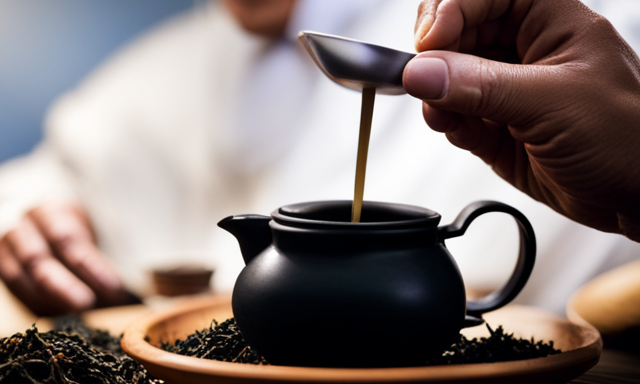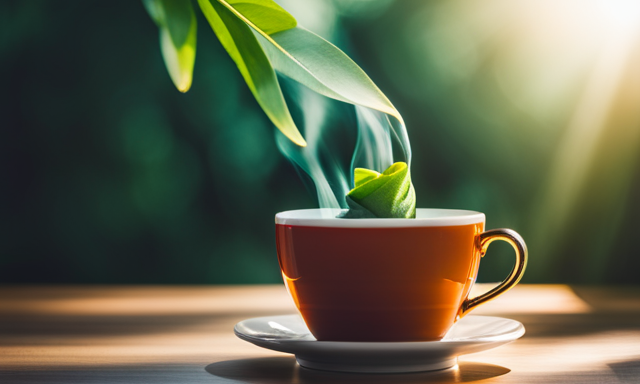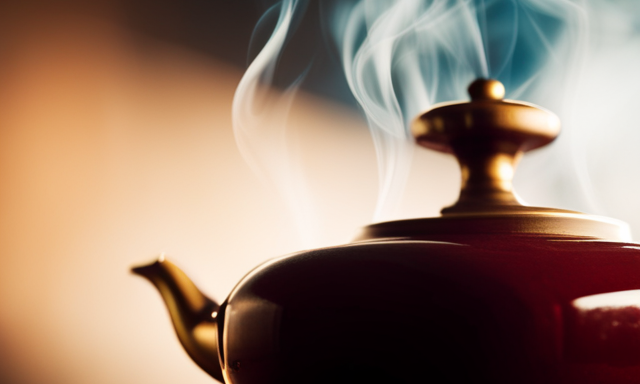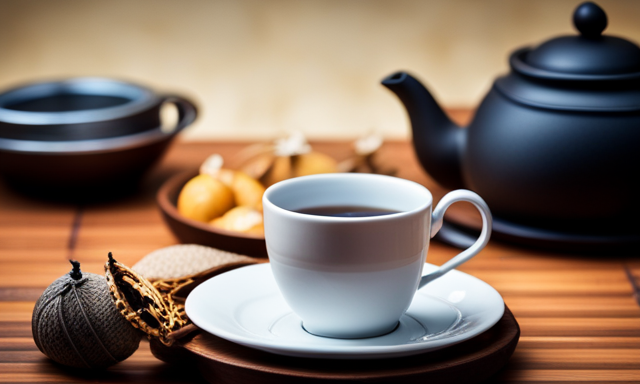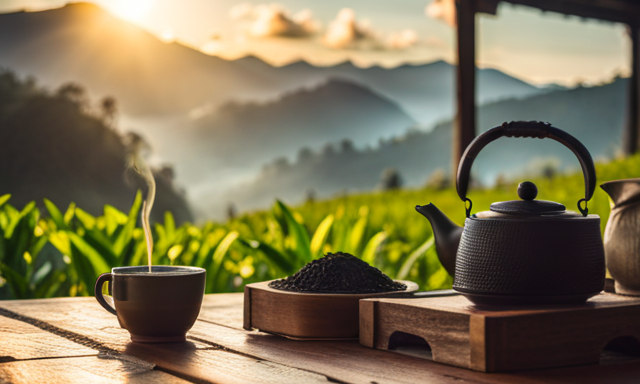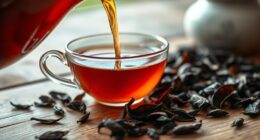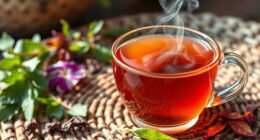As a tea enthusiast, I am always on the lookout for unique and flavorful blends. One tea that has captured my attention is oolong tea. It’s like a symphony of flavors dancing on my taste buds.
Oolong tea is a traditional Chinese tea that falls somewhere between green and black tea in terms of oxidation. Its history dates back centuries, and its origins can be traced to the Fujian province in China.
What sets oolong tea apart is its complex flavor profile, ranging from floral and fruity to toasty and earthy. But what exactly goes into making this exquisite tea? Join me as we delve into the main ingredients and brewing techniques, explore the health benefits it offers, and discover the rich traditions and culture surrounding oolong tea.
So, grab your teapot and let’s embark on a journey to unravel the secrets of oolong tea.
Key Takeaways
- Oolong tea is made from the leaves of the Camellia sinensis plant and is a traditional Chinese tea.
- Oolong tea has a complex flavor profile with floral, fruity, toasty, and earthy notes.
- Oolong tea offers various health benefits, including weight loss, improved mental alertness, and heart health.
- Oolong tea can be brewed using water at a temperature of 180-190°F for 3-5 minutes and can be enjoyed hot or cold.
What is Oolong Tea?
Do you know what makes oolong tea so unique?
Oolong tea is a traditional Chinese tea that falls between green tea and black tea in terms of oxidation. It is known for its complex flavors and aromas, making it a favorite among tea enthusiasts.
Oolong tea comes in different grades, which are based on the quality of the leaves and the level of oxidation. The grades range from light and floral to dark and roasted.
Compared to other types of tea, oolong tea has a more nuanced taste and a rich, smooth texture. It also contains a moderate amount of caffeine, providing a gentle pick-me-up.
Now, let’s delve into the history and origins of oolong tea.
The History and Origins of Oolong Tea
The captivating story behind the creation of this beloved beverage can be traced back to ancient China. Oolong tea has a rich history and fascinating origins that have contributed to its popularity today. The origins of oolong tea can be traced back to the Ming Dynasty, where it was first cultivated in the Wuyi Mountains of Fujian Province. The unique production process of oolong tea involves withering the leaves under the sun and then allowing them to oxidize partially before being twisted or rolled. This intricate process gives oolong tea its distinct flavor and aroma. The history and origins of oolong tea add to its allure and make it a cherished beverage enjoyed by many. Moving on to the next section, let’s explore the different types and varieties of oolong tea.
Types and Varieties of Oolong Tea
Explore the world of oolong tea by discovering the wide array of types and varieties available to you. Oolong tea is known for its rich flavors and complex profiles, making it a favorite among tea enthusiasts.
There are several types of oolong tea, each with its own unique characteristics. From the floral and fruity notes of Tie Guan Yin to the roasted and nutty flavors of Da Hong Pao, there is a type of oolong tea to suit every palate.
Brewing techniques also play a crucial role in bringing out the best in oolong tea. Whether it’s the traditional gongfu style or a simpler steeping method, understanding the right brewing techniques can enhance the taste and aroma of your tea.
Now, let’s delve into the main ingredients of oolong tea and discover what makes it so special.
The Main Ingredients of Oolong Tea
With its delicate leaves and meticulous processing, oolong tea unveils a captivating blend of floral and fruity notes that dance on your taste buds.
Oolong tea is made from the leaves of the Camellia sinensis plant, just like black and green teas. However, what sets oolong tea apart is its unique oxidation process. The leaves are partially oxidized, giving oolong tea its distinct flavor and aroma.
This tea is rich in antioxidants, which can help boost metabolism, promote weight loss, and improve heart health.
There are several ways to enjoy oolong tea, such as brewing it hot or cold, adding a splash of milk or a squeeze of lemon, or even using it as a base for delicious iced tea or bubble tea.
Transitioning into the subsequent section, the flavor profile of oolong tea is as intriguing as its ingredients.
The Flavor Profile of Oolong Tea
Immerse yourself in the enchanting world of oolong tea as its captivating blend of floral and fruity notes twirls on your taste buds, painting a vivid picture of flavor. Oolong tea is known for its complex flavor profile, which can vary depending on the specific type and brewing techniques used. The flavor notes of oolong tea can range from delicate and floral to rich and fruity, with some varieties even offering hints of honey or roasted nuts. To fully appreciate the nuances of oolong tea, it is important to use the proper brewing techniques, such as steeping the leaves at the right temperature and for the appropriate amount of time. This ensures that the flavors are extracted in the most balanced and enjoyable manner. Transitioning into the subsequent section about the health benefits of oolong tea, its delightful flavor is just the beginning of the many reasons to incorporate this beverage into your daily routine.
Health Benefits of Oolong Tea
Indulging in a cup of oolong tea is like sipping on a fountain of youth, as it’s got the power to turn back time. Oolong tea isn’t just a tasty drink, it’s packed with health benefits. Here are some key benefits you can get from regularly drinking oolong tea:
-
Weight loss effects: Oolong tea boosts metabolism and burns fat, making it great for weight loss.
-
Improved mental alertness: The caffeine in oolong tea gives you a natural energy boost and helps you focus.
-
Antioxidant properties: Oolong tea is loaded with antioxidants that protect your body from free radicals and reduce the risk of chronic diseases.
-
Heart health: Drinking oolong tea regularly lowers cholesterol and reduces the risk of heart disease.
-
Digestive benefits: Oolong tea aids digestion and helps with bloating and constipation.
With all these health benefits, it’s no wonder oolong tea is a popular choice for health-conscious people. Now, let’s move on to the next section and learn how to brew oolong tea.
How to Brew Oolong Tea
To brew oolong tea, start by heating water to the appropriate temperature based on the type of oolong tea you’ve chosen, and then steep the tea leaves for the recommended amount of time to achieve the perfect balance of flavor and aroma.
Brewing techniques can vary depending on personal preference, but generally, oolong tea is best brewed with water that’s around 180-190°F. This temperature allows for the delicate flavors to be extracted without becoming too bitter.
As for steeping time, it’s typically recommended to steep oolong tea for 3-5 minutes. This ensures that the tea leaves release their full flavor potential while avoiding any over-extraction.
Once the steeping time is complete, strain the tea leaves and enjoy the rich, complex flavors of oolong tea.
Moving on to oolong tea traditions and culture, we can explore the fascinating history and rituals that surround this beloved beverage.
Oolong Tea Traditions and Culture
Explore the fascinating history and rituals surrounding oolong tea, and discover how it has become an integral part of tea culture in many Asian countries. Did you know that oolong tea is believed to have been first produced over 400 years ago in the Fujian province of China? Oolong tea ceremonies and rituals have been passed down through generations, creating a rich and vibrant tradition. These ceremonies often involve carefully brewing the tea leaves in small clay teapots, and the entire process is steeped in symbolism and respect for the tea. The tea is poured into small cups, and guests are encouraged to savor each sip, appreciating the delicate flavor and aroma. Oolong tea has truly become a cultural treasure, connecting people through shared experiences and cherished rituals. Now, let’s delve into where to buy oolong tea without delay.
Where to Buy Oolong Tea
When it comes to buying oolong tea, there are two main options that I recommend: specialty tea shops and online retailers.
Specialty tea shops are great because they often have a wide selection of oolong teas from different regions, allowing you to try different varieties and discover your favorites.
Online retailers, on the other hand, offer convenience and the ability to compare prices and read reviews before making a purchase.
Whether you choose to explore the local specialty tea shops or browse through online retailers, you’re sure to find a wide range of oolong tea options to suit your taste preferences.
Specialty Tea Shops
Visit specialty tea shops to discover the richness and complexity of oolong tea, immersing yourself in a world of flavors and aromas that will elevate your tea-drinking experience.
At these shops, you can find a wide variety of specialty tea blends, crafted by experts who understand the nuances of oolong tea. These blends combine different types of oolong tea leaves, creating unique flavor profiles that cater to different tastes.
Moreover, specialty tea shops offer a range of oolong tea benefits, such as promoting weight loss, boosting metabolism, and improving heart health. The knowledgeable staff at these shops can guide you through the selection process, helping you find the perfect oolong tea that suits your preferences and desired health benefits.
After exploring the specialty tea shops, let’s delve into the world of online retailers to discover even more options for purchasing oolong tea.
Online Retailers
If you’re craving the convenience of shopping from home, online retailers offer a virtual tea paradise where you can browse and discover an extensive selection of oolong tea blends to satisfy your taste buds.
Online marketplaces have become a haven for tea enthusiasts, providing a wide range of options from different regions and tea gardens. These platforms allow you to explore various flavors and find the perfect oolong tea that suits your preferences.
Additionally, many online retailers offer tea subscription services, allowing you to receive a curated selection of oolong teas delivered right to your doorstep on a regular basis. This not only provides convenience but also introduces you to new and exciting blends that you may not have discovered otherwise.
Embrace the online tea shopping experience and explore the vast world of oolong tea from the comfort of your own home.
Frequently Asked Questions
How is oolong tea different from black or green tea?
Oolong tea is distinct from black or green tea because of its unique flavor profiles and health benefits. It offers a delicate balance between the boldness of black tea and the freshness of green tea, making it a delightful choice for tea lovers.
Does oolong tea contain caffeine?
Yes, oolong tea contains caffeine. It also has numerous health benefits, such as boosting metabolism and aiding in weight loss. Its taste is a perfect balance between the boldness of black tea and the lightness of green tea.
Can oolong tea help with weight loss?
Oolong tea has weight loss benefits backed by scientific evidence. It contains polyphenols that can increase metabolism, reduce fat absorption, and promote fat breakdown.
Are there any potential side effects or risks associated with drinking oolong tea?
There are some potential side effects and risks associated with drinking oolong tea. It may cause digestive issues, caffeine sensitivity, and may interact with certain medications. It is important to consume it in moderation and stay within the recommended daily intake.
Can oolong tea be consumed hot and cold?
Yes, oolong tea can be consumed both hot and cold. Hot oolong tea is soothing and can help with digestion, while cold oolong tea is refreshing and can provide hydration.
Conclusion
In conclusion, Oolong tea is a captivating blend of flavors and traditions that has stood the test of time. Its rich history and origins add a layer of depth to each sip, transporting you to a world of ancient tea ceremonies and cultures.
With its unique flavor profile and numerous health benefits, Oolong tea is a delightful choice for tea enthusiasts. Whether enjoyed alone or as part of a tea ceremony, this exquisite tea can be easily found in specialty tea shops or online, allowing you to experience its magic wherever you may be.

